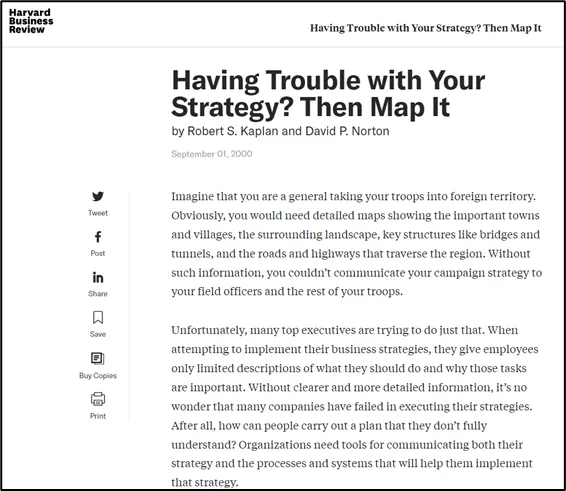Having trouble with your Data Strategy? Then map it!
August 9, 2023
John Apathy

Connecting data products to business value can be transformational…for both the business domain and your data product strategy.
If the headline above sounds familiar…it’s likely because it was first introduced in the context of business strategy in the seminal article by Kaplan and Norton in the Harvard Business Review (September 2000) titled “Having trouble with your strategy? Then map it” (https://hbr.org/2000/09/having-trouble-with-your-strategy-then-map-it).

The seminal HRB article on Strategy Mapping by Kaplan and Norton (Sept, 2000)
Strategy mapping is a process of visualizing and communicating an organization’s business strategy — where does it want to go strategically and how should it get there. It is a way of gaining consensus on strategic priorities, showing how the different parts of an organization’s strategy fit together, and making clear how each contributes to the overall success of the organization.
From my own personal experience, it’s clear to me that the value and impact of strategy mapping can vary depending on the profile of the organization and the way in which it is implemented, with several influencing variables such as — organizational maturity, culture, commitment, sense of urgency, leadership literacy, sustained sponsorship, etc. However, strategy mapping can have a positive impact on an organization’s performance by improving communication, alignment, decision-making, sponsorship, and performance improvement.
Want to understand the purpose and value of data — make sure it maps to strategic priorities
Data is created, purchased, captured, analyzed, leveraged, integrated, used, etc. for many business reasons and under a wide range of circumstances and domain-contexts. Connecting the act of its creation and use to how it helps to drive an organization’s value creation engine helps to understand the data economy of the organization and is critical to fully understanding and mapping its value and proper management and investment throughout its lifecycle.
Mapping data…and by extension — data products, to business value drivers and use cases is an important step in the process of creating and managing data products in a large organization. By taking this step, businesses can ensure that their data products are aligned with their overall business goals and that they are providing value to the business. Gone are the days of building new pipelines for every project and need. We believe the concept of data products will close the gap in helping companies respond faster to change.
What are data products?
Data products are a way of packaging and managing data, analytics, and generative models (LLMs as endpoints of course must be included now!), just as you would manage the company’s products — e.g., in a way that meets customer needs, is easily consumable and has utility to the business users of data. But not all data products are created equally, as there is very much a hierarchy and a network effect to their utility and design, with Core data products filling the role of re-usable units of data that can combine with other data to make up a Derived data product that has higher complexity, serves a specific use case (or many use cases), and drives tangible business value. They can be used as the fundamental building blocks for the use cases that solve a wide range of business problems, from improving customer satisfaction, to reducing cost, and accelerating the discovery and development of new medicines for patients.
This stratification of data products helps to organize the data ecosystem and brings into focus how data maps to business value.
Getting benefit from connecting data to strategy
Business value drivers are factors that contribute to the success of a business, and underpin strategic objectives and value creation. They can be financial, operational, or strategic. By mapping data products to business value drivers, businesses can ensure that their data products are aligned with their overall business goals. Additionally, the organization can more closely align its investments in technology and data with business value, seeking to create a network effect from each investment as it build-outs from a core and delivers against additional use cases.
Use cases are specific examples of how a data product can be used to solve a business problem. By mapping data products to use cases, businesses can ensure that their data products are meeting the needs of their customers and users.
We have found great benefit from the simple act of pulling together stakeholders and key participants into Data Product Mapping workshops as part of the business and data analysis and assessment phase when constructing a Data Strategy for an organization. This mapping creates a clear and compelling linkage between the creation and organization of transactional data all the way through to high value business drivers.
One recent example clarified the impact of data quality in the core data product, Clinical Trial Investigator within the Clinical Trial Planning and Execution value driver within a major pharmaceutical company’s Global Drug Development domain. This use case requires a variety of data products and supports the high value business driver of R&D Pipeline Acceleration.
The structure of that analysis resulted in the following Pipeline Acceleration map, highlighting a range of core and derived data products critical to building the organization’s knowledgebase within this key domain.

The Pipeline Acceleration business value driver and associated data ecosystem for improving data driven decision-making for Clinical Trial Planning and Execution (highlighting the core data product — Investigator).
How to map data products to business value drivers and use case?
The following steps can be used to map data products to business value drivers and use cases:
1. Identify the business value drivers for your organization — work backwards from the most important revenue and/or cost drivers within the business. Sometimes “indirect” value measures must be accounted for as business drivers, such as cycle-time, yield, attrition, reputation, talent.
2. Identify the use cases that address each business value driver — supporting each value driver are likely a series of processes and/or data-driven decisions. These use cases require clean, authoritative data and drive the business forward.
3. Identify the data products that can be used to support each use case — not all data products are the same, with core data products serving as the foundational data that feeds into more sophisticated and higher value derived data products.
4. Map the data products to the business value drivers and use cases — mapping is more than just connecting boxes on a slide. It should represent a relationship between entities that captures actions and outcomes.
Benefits of mapping data products to business value drivers and use cases
There are several benefits to mapping data products to business value drivers and use cases, including:
Improved communications: Any type of strategy mapping can help to improve communication within an organization by providing a common language and framework for discussing strategy. This can help to ensure that everyone in the organization is on the same page and that they are working towards the same goals.
Increased alignment with business goals: By mapping data products to business value drivers, businesses can ensure that their data products are aligned with their overall business goals. This helps to ensure that the data products are used effectively and that they are providing value to the business.
Improved decision-making: By mapping data products to use cases, businesses can make better decisions about how to use their data. This is because they will have a better understanding of the specific problems that the data products can solve and the benefits that they can provide.
Increased efficiency and performance: By mapping data products to business value drivers and use cases, businesses can identify opportunities to improve efficiency. This is because they will be able to see which data products are not being used effectively and which ones could be used to solve new problems.
Improved business cases and rationale for investment: By mapping data products to business value drives and use cases, businesses can strengthen the argument for investment, whether in data or technology. Through building stronger linkages to value, investment cases and the business case to move forward becomes clearer — and priorities almost write themselves!
Still not sure if you need to do Data Product Mapping?
Do these symptoms sound familiar for your organization’s data strategy — weak business sponsorship, no clear business case, inability to get prioritization for funding, fractured and/or fragmented stakeholders with no clear consensus on “where to get started”? Have you been through a “use case hunt” with little impact or outcome?
For all of you out there struggling with these challenges, then understanding how data products interact and come together to solve the highest value business challenges may be an important step in your journey — and Data Product Mapping may just be the necessary first step to address the underlying root cause of many your symptoms — lack of clarity and consensus.
Of course, I would love to hear from you on this (and any other topic). Contact me if you would like to start a dialogue on how mapping your Data Products can add value to your organization (john.apathy@xponentl.ai).
Acknowledgements — I would like to thank and embarrass through compliments our rock-star intern — Kathryn Reda. Whether she knew it or not at the time she was critical to the design thinking on Data Product Mapping and contributed her many talents to its creation and design. Despite our best efforts to keep her working with XponentL, Kathryn is headed to Oxford in the fall to complete her Masters in Pharmacology and we wish her all the best!
